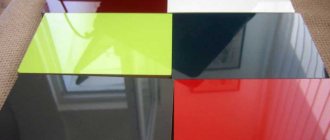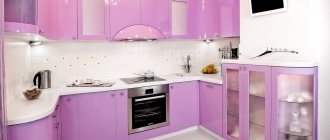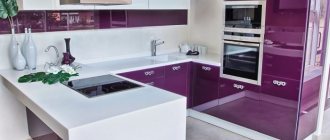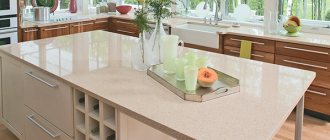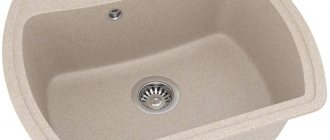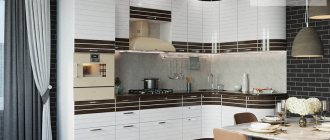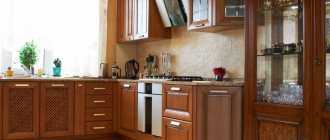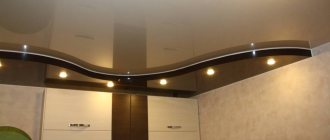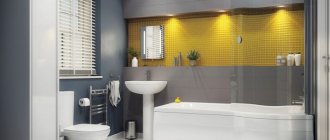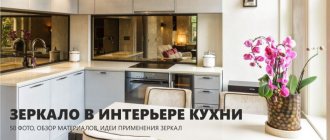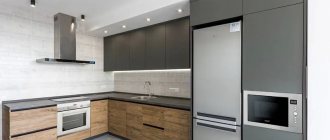A kitchen set is always notable for its facades; they play a fundamental role and create the overall style of the kitchen. For several years, the most popular material for making facades has been acrylic. The fashion for it came to Russia from Italy.
The material has proven itself on the positive side and has gained popularity. However, like any other material, acrylic has disadvantages.
Let's look at the features of acrylic facades and find out their main advantages.
What are acrylic facades?
At first glance it may seem that the panels are made of plastic. This is wrong. Thin MFD or chipboard panels are covered with special sheets of polymethacrylate, more often called acrylic.
MDF panels coated with acrylic.
This helps to ensure not only strength, which is important for furniture facades, but also wide design possibilities, as well as a characteristic glossy shine. MDF with acrylic coating is absolutely harmless, does not emit toxins when heated, and with proper care will last for many years.
High-gloss acrylic panels are easy to clean and do not fade over time. In addition, the properties of acryline help it not to absorb dirt and grease.
Manufacturing materials
There are a number of requirements for the base under acrylic coating:
- smooth surface;
- dense structure;
- low porosity.
MDF fiberboard with a thickness of 16-18 mm fully fits the description.
Chipboard is considered a more affordable option in furniture production, but in this case such savings are questionable. Particle boards cannot boast of density, uniformity, and the front side contains irregularities.
Manufacturing technology of acrylic facades for kitchens
There are two ways to manufacture such facades: one-sided and two-sided. In the first case, the acrylic sheet is glued only to the outer part, leaving the inner part untreated. In the second, both sides of MDF or chipboard are glued, providing the doors with the same appearance from the inside and outside.
The coating is glued using a special glue (for example, Cosmofen or Akrifix), and then placed under a press. In this case, the sections are covered with a waterproof acrylic edge, which prevents peeling of the decorative layer. The thickness of such a facade often does not exceed 16-18 millimeters.
A more expensive option is solid acrylic panels up to four millimeters thick, edged with aluminum. Metal adds strength to them, comparable to chipboard, but they are much more difficult to maintain and are quite expensive.
This is not plastic
See also
How to make a folding table with your own hands
Here I would like to talk a little in defense of acrylic. Some smart people, as well as sofa experts, often claim that acrylic is the same plastic.
And all the fashionable furniture stores represented in cities such as Moscow, Yekaterinburg, St. Petersburg, under the guise of supposedly unique modern furniture, sell ordinary plastic products. This is wrong. There is only a grain of truth in their statements.
[adv2]
Acrylic is correctly called pure, high-quality plastic, which is based on recycled petroleum products. That is, to some extent we are talking about types of plastic. But this is the same as saying that all types of trees or types of metal are identical. There are different types of plastic. From a technical point of view, cheap chipboard can be considered wood. But it cannot be compared with solid wood. And the same aluminum is not equal to gold, platinum or silver.
Acrylic can also be called plexiglass or perspex. This is the highest quality material, and so the manufacturer decided to stand out, create a brand, a unique name for its product.
Pros and cons of kitchens with acrylic facades
In addition to appearance and ease of installation, such facades have a number of advantages:
- Wear resistance. The strength of acrylic reliably protects it from damage due to impacts and scratches. In addition, damaged acrylic panels can be reconstructed to their original appearance. With proper care, they will last up to 20 years.
- Acrylic does not react to temperature changes and is resistant to heating up to 160 degrees. It does not deform when exposed to water, and does not fade from sunlight.
- Grease, soot and dust are not absorbed into the surface ; it can be easily cleaned with a simple detergent and a soft cloth. We recommend: Once every three to four months, treat facades with sprays that help maintain a glossy shine, for example, Weiss or Cosmofen.
- Large selection of design solutions. Acrylic panels are presented in a wide palette. In addition, you can decorate them with prints or airbrushing or decoupage.
- The glossy structure due to its reflective properties makes the room lighter and more spacious .
- Acrylic panels, unlike plastic ones, do not release toxic impurities into the air when heated. Therefore, acrylic can be considered an environmentally friendly material.
However, it was not without its drawbacks:
- Due to the manufacturing technology, acrylic facades are quite expensive . The cost of a solid acrylic facade can reach $600 per linear meter, and an acrylic coating can cost $100. At the same time, taking into account the quality, the price can be considered relatively affordable: the long service life fully pays for the costs of manufacturing and installation.
- The glossy surface is very difficult to handle. It does not scratch or chip, but any fingerprints and dust become much more noticeable. You will have to regularly wipe away streaks and stains. Please note: Special grease-repellent polishes will help prevent the problem.
- High shine. The disadvantage is conditional, but over time many people begin to be annoyed by the glossy mirror structure of the acrylic facade.
Production technology
Acrylic kitchen facades are made from acrylic plates by sawing into pieces with the required parameters. Acrylic board, in turn, is manufactured using high-tech equipment by combining two components: MDF board and acrylic.
The acrylic layer is a plate approximately 1 mm thick that covers the MDF board. They are connected to each other by rolling. The temperature effect on the parts helps to achieve perfect adhesion of materials to each other.
Acrylic facades are divided into two types depending on the fastening of the acrylic plate:
- Double-sided - an acrylic board is attached to both sides of the MDF. Accordingly, the facades both inside and outside will be made of the same material and will be the same color.
- One-sided - fastening the acrylic plate only from the front side. The kitchen facades will be framed with colored acrylic only on the outside; on the other side there will be an MDF board. This method of constructing kitchen parts is usually resorted to in an effort to reduce the cost of the set. Visually, the kitchen will look the same as with double-sided processing, but its cost will be significantly lower. You can only notice the difference when you open the cabinet.
You can reduce the cost of a kitchen with acrylic facades by replacing the MDF board with a chipboard board. Externally, the kitchens will also not be different. At the same time, parts made from MDF are much stronger and will last longer.
The technology for manufacturing acrylic boards is available to only a few furniture factories in Russia due to the high cost and specificity of the equipment necessary for its creation. Other furniture factories work with ready-made raw materials. Creating a furniture set involves cutting a finished acrylic board into pieces of the required size. In this case, the edge plays a decisive role.
You can process the edges using two methods:
- Attaching a regular soft edge to the edge using low-temperature glue - this technology is most often used due to its ease of execution and accessibility. This edge framing does not require additional equipment and can be done by any craftsman in a furniture workshop.
- Laser edging is a more complex option, but also the most durable. The edge is soldered into the MDF board using a special laser. This method creates a feeling of integrity of the parts. After this treatment, the edge will not peel off, will not swell from moisture, and will not dry out near hot radiators in winter.
- Aluminum edge is the most durable option for making a facade, but this method is much more expensive.
Advice! When choosing a kitchen set with acrylic facades, you should give preference to laser edging; this will significantly extend the life of the kitchen set and ensure the proper appearance of all parts for the entire service life.
What is better to choose for kitchen facades: acrylic or plastic?
As mentioned above, acrylic is much more environmentally friendly than plastic. But is this the only difference? We offer a comparative table of the two materials.
| Acrylic facades. | Plastic facades. | |
| Gloss. | Clearly expressed, with a mirror shine. | Compared to acrylic, plastic is duller. There are matte options. |
| Temperature resistance. | It tolerates heating up to 160 degrees without releasing toxic impurities. | Good HPL or CPL plastic can withstand temperatures up to 140 degrees, but cheap options begin to release toxins at 80 degrees, so they should not be placed near the stove. |
| Term of use. | With proper use - up to 20 years. | After just a couple of years, it may begin to fade from heat and direct sunlight. |
| Price. | High-quality acrylic will cost you quite a lot. | Affordable price. |
| Facade type. | Only deaf. | Deaf and radius. |
Let's summarize: Acrylic facades are more durable and reliable, but the price is not encouraging. At the same time, plastic facades are more affordable, but they are more capricious in everyday use and they cannot be placed next to heat sources.
Acrylic - what is it, coating features
Acrylic is a thermoplastic material that is obtained by the polymerization of monomer compounds. It is a type of transparent plastic that can be easily painted in different colors. The scientist Otto Rohm is considered its creator.
In 1933, Germany launched industrial production of the material. Similar work was carried out in the Soviet Union. Since 1936, they have been studied at the Research Institute of Plastics.
Modern acrylic has high technical characteristics.
- UV resistance.
- Durability.
- Light weight.
- Ease of processing.
- Hygiene.
- Strength.
- No harmful fumes.
- Melts when heated above 160°C.
What color should acrylic facades be made in?
The design palette for acrylic facades is extremely wide. Many colors and shades, the possibility of decorative design. We invite you to look at the most popular options among designers - perhaps you will find your ideal kitchen.
A white acrylic kitchen is a great choice for small spaces. Due to the color and glossy texture, it reflects light, visually enlarging the room and making it lighter and more spacious. However, keep in mind that such facades are very difficult to maintain - all the dirt and drops of grease are visible on the white surface, so you will have to wash the set often.
An interesting solution is a black and white acrylic kitchen . The classic combination looks very catchy thanks to the mirror shine. However, it is important to maintain a balance here: it is better if the colors are combined with each other, and do not overwhelm each other.
If such a combination seems boring to you, dilute it with another shade - it is better to choose bright colors, for example, pink, light green, blue.
Bright red is on trend right now, but we recommend being careful with it. Aggressive tones quickly tire the eyes, so monochromatic design in this case is not the best choice. Dilute it with calmer, pastel shades - beige, gray, golden.
The same applies to yellow kitchens. However, it all depends on the chosen tone. Soft colors will make the kitchen fresh and brighter, but bright colors require a muted edging.
A monochrome black kitchen is a bold but very stylish solution. It is important to pay attention to details: any inappropriate accessory, the slightest contamination - and the impression is ruined.
Color combinations for acrylic kitchens
White
A universal color that will suit rooms of all sizes and styles. White furniture will visually expand the space and add light, so such sets can be used in small kitchens. The advantages of white also include an unlimited number of color combinations: it can be combined with black, gray, pastel and bright shades.
Grey
Gray acrylic fronts are another universal option for kitchen furniture. You can use light shades: in visual perception they are close to white, but they look more interesting. At the same time, light gray combines with other colors just as well as white. Dark shades of gray are perfect for high-tech and similar styles. For example, they can be used for the lower row of cabinets, and make the upper level lighter.
Beige
Acrylic kitchen set will look good in beige color. Warm shades create coziness and make the kitchen more convenient and comfortable. If the room is small, beige can become the main color. The shade is also suitable for two-tone sets: for example, you can use it with white or gray.
Black
Installing a black set is a bold step that is only suitable for spacious and bright rooms. However, glossy acrylic facades, even in black, do not make the kitchen too gloomy. In addition, they can be diluted with lighter shades. Dark gloss also has a drawback - dirt is clearly visible on it, so you will have to spend a lot of time caring for the furniture.
Bright colors
To make the kitchen brighter, you can use sets of purple, red, orange, yellow and other rich shades. At the same time, it is important not to overdo it with bright colors: they should be used with caution, if necessary, combined with white or other neutral light shades.
Manufacturers of acrylic kitchen facades
Acrylic panels are produced by dozens of manufacturers with very different pricing policies.
We offer you the TOP 3 manufacturers popular in Russia:
- Bel Viso using NIEMANN panels. Polish acrylic facades are one of the most famous. A wide selection of decorative designs, a huge color palette and high quality. The price, however, is appropriate - from $150 per linear meter.
- The Sidak company , located in the Leningrad region, will also not please you with the price tag - from $140 per meter. However, the factory goes through the full production cycle: from the panel to the finished facade, which affects the quality.
- Fordom is a more budget option. Turkish facades will cost you an average of $90 per meter. Of course, you can also find cheap acrylic facades. But be careful - most often the tempting price tag hides a low-quality coating or simple plastic, sometimes not even heat-resistant.
Recommendations for care and use
Unfortunately, the perfectly smooth and shiny surfaces of facades quickly become dirty. They show small droplets of water and grease, as well as fingerprints. Therefore, daily surface care is a mandatory ritual if you want your kitchen set to always be beautiful and tidy. Otherwise, the “soul of the house” will irritate instead of delight.
Daily cleaning is quite simple: you need to wipe the surfaces with a soft damp cloth. Microfiber cloths are best suited for these purposes. If there are strong and persistent stains, you can additionally use a soap solution or a mild detergent.
Manufacturers do not recommend using chemical or abrasive products.
To add shine and remove stains from detergents, you can use glass cleaners containing alcohol.
I would also like to talk about acrylic polish. After all, no matter how carefully and carefully you try to use the surfaces, small scratches cannot be avoided. To add aesthetics to an acrylic set, you can purchase a polish specially created for this purpose in furniture stores. It will restore its original shine and hide minor damage.
Reviews from real owners of acrylic kitchens
If you look at the reviews of people who bought acrylic facades for their kitchen, you will notice one common point - everyone admires their beauty and durability, but emphasizes the capriciousness of their care. Most often, this means the need for regular cleaning.
However, some people think that wiping the facade once a month is enough, but the only disadvantage is the cost.
And some people don’t like the need to use special care products.
Sometimes a change in shade depending on the lighting is noted. Therefore, be careful with pastel colors - in the twilight they may appear dull.
However, the reviews are unanimous on one thing - acrylic facades are reliable, durable and beautiful.
Stylistic decisions
Acrylic products look very impressive in modern high-tech interiors. This style reflects all the achievements of mankind over the past decades: advanced computer technologies in the form of a touch-sensitive countertop, sound sensors that respond to commands, computers and screens built into the surface will be very appropriate in such a kitchen. A glossy set will highlight the cosmic interior, making it more stylish and unearthly. The same applies to minimalism, which is characterized by strict forms, conciseness and an almost complete absence of decor.
The most attractive interior looks with glossy panels, decorated in one direction.
White gloss is an excellent choice for limited space
For those who are more keen on comfort, the Art Nouveau style is suitable. It is characterized by smooth rounded shapes and asymmetrical lines. Wavy facades made of acrylic will fill the room with light and warmth, and a stalinite apron will add originality. A two-color set looks unusual and playful, where one color is a basic neutral, and the second is a rich, bright one. For example, milky and red. In recent years, the color eggplant has become particularly popular, but it is more suitable for large kitchens, since it will look gloomy in small spaces.
Acrylic should not be used in classic interiors and rustic country and Provence styles, as it will disrupt the entire concept and originality of the designs. Here, give preference to wood and other natural materials without shine or gloss.
Products made from acrylic always look impressive and attractive, especially since they are environmentally friendly. However, when choosing a kitchen, take into account the wishes of your household and pay attention to the warnings of psychologists so as not to make a mistake in your decision.
How to care for acrylic facades
As can be seen from the reviews, the main problem with acrylic facades is their maintenance. How to properly care for the panels?
Now we'll tell you:
- Do not use aggressive abrasive detergents.
- When choosing what to wash the panel with, stick to the mildest possible detergents - for example, regular dishwashing detergent.
- Use lint-free soft cloths.
- Wipe the surface regularly to prevent fingerprints and dirt from accumulating on it.
- Use polish for acrylic kitchen facades - it will make cleaning much easier.
Let's summarize: With proper care, an acrylic facade is an excellent choice for kitchen design. A beautiful, eco-friendly and durable set will become a real decoration of the room. Among the disadvantages, we note the high price - however, taking into account the durability of such furniture, it is completely justified.
What styles is acrylic not suitable for?
Plastic is practically not used in classical styles, in which the emphasis is on traditional materials. An exception may be sets with matte facades: the material is suitable for the neoclassical direction. Doors with a matte finish can be combined with stone countertops (natural or composite), as well as with wooden surfaces, as well as with metal.
Furniture made from polymethyl methacrylate is also not suitable for country, Provence and other rustic styles, in which gloss and artificial materials can destroy comfort. For such interiors, it is better to buy a kitchen with painted or veneered furniture; solid front parts are also suitable.
Kitchens with acrylic facades photo examples
Advantages of acrylic paint for furniture
Acrylic composition is often used for painting due to its quick drying, fire safety and safety for human health. The absence of an unpleasant odor allows the paint to be used for indoor work. The product has good adhesion, i.e. adhesion to wood, as well as the elasticity of the coating, which allows you to use the composition economically.
The paint is suitable for treating any surface:
- plywood;
- OSB;
- MDF;
- Chipboard.
Water-based paint has a white color, which can be changed by coloring. Many acrylic products contain antiseptic additives that prevent the appearance of fungus and mold. Due to this, the life of wooden products is extended.
Some acrylic compositions contain water- and dirt-repellent additives, which allow you to clean wood furniture less frequently. The moisture-resistant option is suitable for products in rooms with high humidity, such as bathrooms or kitchens.
Before drying, the coloring agent can be washed off the product with water, if necessary. For wood, you can use transparent paint, which will protect the surface from external influences and emphasize the natural shade of the material.
The advantages of the dye include its resistance to ultraviolet radiation. Thanks to this, the product retains its original color for a long time.
